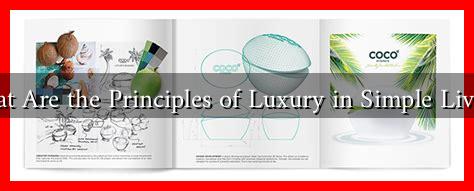-
Table of Contents
- What Are the Principles of Luxury in Simple Living?
- The Essence of Luxury in Simple Living
- Mindfulness: The Foundation of Simple Luxury
- Quality Over Quantity: The Art of Selective Consumption
- Connection with Nature: A Luxurious Escape
- Intentional Living: Making Conscious Choices
- Experiential Wealth: The True Luxury
- Conclusion: Embracing Luxury in Simple Living
What Are the Principles of Luxury in Simple Living?
In a world increasingly obsessed with consumerism and material wealth, the concept of luxury in simple living has emerged as a refreshing counter-narrative. This philosophy emphasizes quality over quantity, mindfulness over mindlessness, and experiences over possessions. But what exactly are the principles that define luxury in simple living? This article explores these principles, providing insights and examples that illustrate how one can embrace a luxurious yet simple lifestyle.
The Essence of Luxury in Simple Living
Luxury in simple living is not about opulence or extravagance; rather, it focuses on the richness of experiences and the quality of life. It is about finding joy in simplicity and appreciating the finer things that life has to offer without the clutter of excess. Here are some core principles that define this approach:
- Mindfulness: Being present and fully engaged in the moment enhances the appreciation of life’s simple pleasures.
- Quality over Quantity: Investing in fewer, high-quality items that bring joy and serve a purpose is a hallmark of luxury in simple living.
- Connection with Nature: Embracing the natural world fosters a sense of peace and fulfillment, often seen as a luxury in today’s fast-paced society.
- Intentional Living: Making conscious choices about how to spend time and resources leads to a more meaningful existence.
- Experiential Wealth: Prioritizing experiences—such as travel, learning, and relationships—over material possessions enriches life.
Mindfulness: The Foundation of Simple Luxury
Mindfulness is a crucial principle in luxury simple living. It encourages individuals to slow down and savor each moment. For instance, rather than rushing through a meal, one might take the time to appreciate the flavors, textures, and presentation of the food. This practice not only enhances the dining experience but also fosters gratitude for the nourishment provided.
According to a study published in the journal Psychological Science, mindfulness can lead to greater life satisfaction and well-being. By being present, individuals can cultivate a deeper appreciation for their surroundings and experiences, which is a key aspect of luxury in simple living.
Quality Over Quantity: The Art of Selective Consumption
In a consumer-driven society, the idea of quality over quantity is revolutionary. Instead of filling homes with numerous items, luxury in simple living advocates for a curated selection of high-quality possessions. This could mean investing in a few well-made clothing pieces, artisanal home goods, or handcrafted furniture that not only serve a purpose but also bring joy and aesthetic pleasure.
For example, the minimalist lifestyle popularized by figures like Marie Kondo emphasizes keeping only those items that “spark joy.” This approach not only declutters physical space but also mental space, allowing individuals to focus on what truly matters.
Connection with Nature: A Luxurious Escape
Incorporating nature into daily life is another principle of luxury in simple living. Nature has a calming effect and can significantly enhance well-being. Activities such as hiking, gardening, or simply spending time outdoors can provide a sense of luxury that is often overlooked.
Research from the University of Exeter indicates that spending time in nature can reduce stress and improve mood. This connection to the natural world is not only luxurious but essential for mental health in our increasingly urbanized lives.
Intentional Living: Making Conscious Choices
Intentional living involves making deliberate choices that align with one’s values and goals. This principle encourages individuals to evaluate their daily habits and routines, ensuring that they contribute to a fulfilling life. For instance, choosing to spend time with loved ones instead of accumulating more possessions can lead to deeper connections and lasting happiness.
Statistics from the Statista show that people who prioritize relationships over material goods report higher levels of satisfaction and happiness. This reinforces the idea that luxury can be found in meaningful experiences rather than in physical items.
Experiential Wealth: The True Luxury
Finally, experiential wealth is a cornerstone of luxury in simple living. This principle emphasizes the importance of experiences—traveling, learning new skills, or spending quality time with family and friends—over accumulating material possessions. Experiences create lasting memories and foster personal growth, which are invaluable in the pursuit of a fulfilling life.
According to a study by Psychological Science, people derive more happiness from experiences than from material goods. This finding supports the notion that luxury can be found in the richness of life experiences rather than in the accumulation of things.
Conclusion: Embracing Luxury in Simple Living
In conclusion, the principles of luxury in simple living revolve around mindfulness, quality over quantity, connection with nature, intentional living, and experiential wealth. By embracing these principles, individuals can cultivate a lifestyle that is not only luxurious but also deeply fulfilling. In a world that often equates luxury with excess, simple living offers a refreshing perspective that prioritizes quality of life over material accumulation. Ultimately, true luxury lies in the richness of our experiences and the depth of our connections with ourselves, others, and the world around us.


